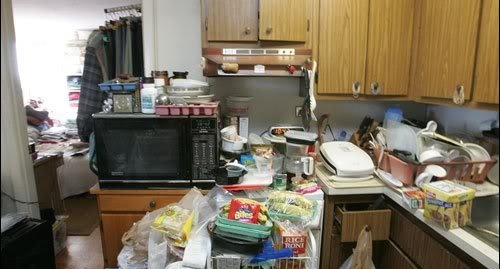Hoarding and Mitigation Our homes, offices, cars, and businesses can all get a little cluttered from time-to-time. Typically, within an hours’ time and some quick organizing, we can get things straightened up and things put away. At that point it is then back to life as normal. But what happened when clutter becomes hoarding? What are the safety risks?
Studies show that compulsive hoarding affects up to 6 percent of the population in the United States (that is approximately 19 million Americans).
Hoarding is classified as a mental disorder that can be genetic, it could be triggered by a traumatic event, or another disorder, such as depression, obsessive compulsive disorder or dementia. Studies suggest that hoarding usually begins in early adolescence and will generally get worse as a person ages.
So what exactly is hoarding and what are the characteristics of a hoarder ?
There are different types of hoarders, the pack rat, the collector, and the all-out hoarder. However, they all have essentially the same characteristics. They have an intense emotional attachment to the things they collect. Others around them could very likely see the things as trivial, but not the hoarder. Another characteristic is that hoarders see the items that they collect as having the possibility of being very useful one day. Because hoarders accumulate so many possessions that congest living or work areas to the point that they can no longer be used or lived in, hoarders have created a host of fire safety risks to themselves, others who come into the home and the fire and emergency response teams. Compulsive hoarding presents a serious fire hazard because exits like hallways, doors, and windows become blocked by clutter. This prevents the residents from escaping and firefighters from finding the resident in a fire. Residents and firefighters can be injured tripping over items when trying to escape, or mounds of possessions fall on them and they become trapped under the debris. Hoarding also adds an additional risk of structural damage due to the weight of the hoarded items. That excessive amounts of items easily adds fuel to a fire, therefore making it difficult to suppress and an increased risk of a fire being reignited. Beyond the risks to the resident and fire personnel in that home, neighbors can also be affected from the environment of a hoarder’s home. In the event of a fire, those living next door can experience excessive smoke and fire conditions. However, on a day to day basis the homes also can create an infestation of vermin that can spread diseases.
It is important for insurance and restoration professionals to keep a few things in mind when working the claim of a hoarder:
- Show respect to the individual and concern for their safety. Creating a bond of trust is extremely important.
- Focus on the safety/health issues that we mentioned above and relate it to their personal well-being.
- Listening to the homeowner (s) when they speak as they describe their belongings. As much as possible, try to use similar language when referencing them. Avoid any reference to trash, junk and hoarding.

